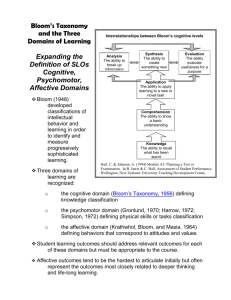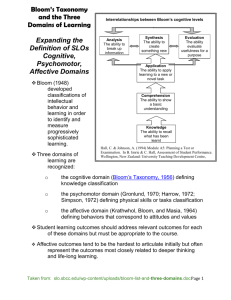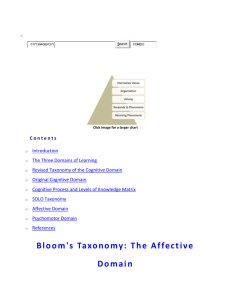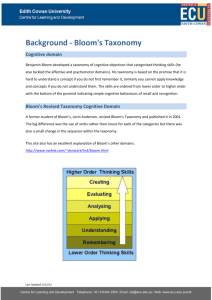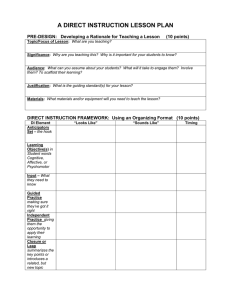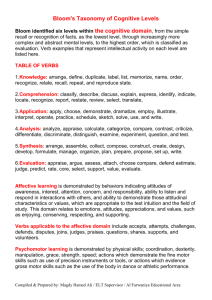SLOs, Bloom’s Taxonomy, Cognitive, Psychomotor, and Affective Domains.
advertisement
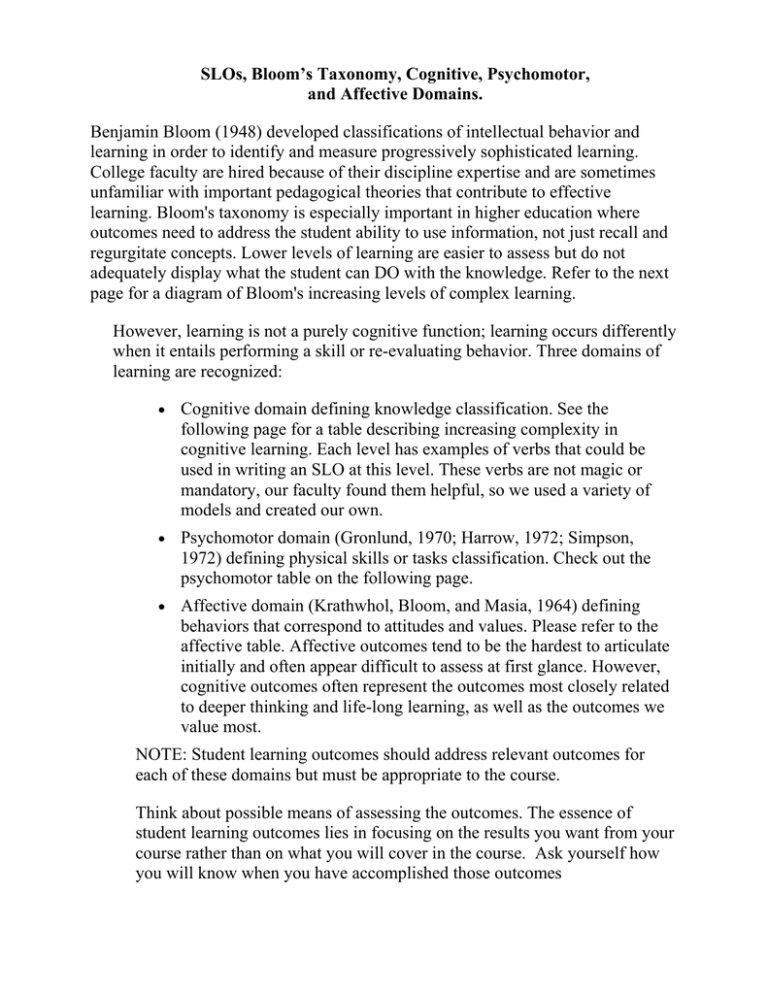
SLOs, Bloom’s Taxonomy, Cognitive, Psychomotor, and Affective Domains. Benjamin Bloom (1948) developed classifications of intellectual behavior and learning in order to identify and measure progressively sophisticated learning. College faculty are hired because of their discipline expertise and are sometimes unfamiliar with important pedagogical theories that contribute to effective learning. Bloom's taxonomy is especially important in higher education where outcomes need to address the student ability to use information, not just recall and regurgitate concepts. Lower levels of learning are easier to assess but do not adequately display what the student can DO with the knowledge. Refer to the next page for a diagram of Bloom's increasing levels of complex learning. However, learning is not a purely cognitive function; learning occurs differently when it entails performing a skill or re-evaluating behavior. Three domains of learning are recognized: • Cognitive domain defining knowledge classification. See the following page for a table describing increasing complexity in cognitive learning. Each level has examples of verbs that could be used in writing an SLO at this level. These verbs are not magic or mandatory, our faculty found them helpful, so we used a variety of models and created our own. • Psychomotor domain (Gronlund, 1970; Harrow, 1972; Simpson, 1972) defining physical skills or tasks classification. Check out the psychomotor table on the following page. • Affective domain (Krathwhol, Bloom, and Masia, 1964) defining behaviors that correspond to attitudes and values. Please refer to the affective table. Affective outcomes tend to be the hardest to articulate initially and often appear difficult to assess at first glance. However, cognitive outcomes often represent the outcomes most closely related to deeper thinking and life-long learning, as well as the outcomes we value most. NOTE: Student learning outcomes should address relevant outcomes for each of these domains but must be appropriate to the course. Think about possible means of assessing the outcomes. The essence of student learning outcomes lies in focusing on the results you want from your course rather than on what you will cover in the course. Ask yourself how you will know when you have accomplished those outcomes Interrelationships Between Bloom’s Cognitive Levels Analysis Synthesis Evaluation The ability to break up information logically The ability to create something new The ability evaluate usefulness for a purpose Application The ability to apply learning to a new or novel task Comprehension The ability to show a basic understanding Knowledge The ability to recall what has been learnt Hall, C. & Johnson, A. (1994) Module A5: Planning a Test or Examination. In B. Imrie & C. Hall, Assessment of Student Performance. Wellington, New Zealand: University Teaching Development Centre, Victoria University of Wellington. Cognitive Domain Le earning Outcomes Re elated To Knowledge K e Kn nowledge Comprrehension Applica ation An nalysis Synth hesis Evvaluation Stu udent rem members orr reccognizes info ormation orr spe ecifics as com mmunicated d with h little perrsonal asssimilation. Studentt grasps the e meaning g behind the inforrmation and d interpretts, translate es, or comp prehends the informattion. Studentt uses informattion to relate and apply it to a uation new situ with min nimal instructo or input. Sttudent disscriminatess, organizes, an nd sccrutinizes asssumptions in an n attempt to o ide entify evvidence for a co onclusion. Studen nt creativvely appliess knowle edge and analysis to integra ate concep pts or constru uct an overalll theory. Stu udent jud dges or eva aluates info ormation bassed upon sta andards and d criteria, vallues and opiinions. Cite e Lab bel Listt Enu umerate Ide entify Imitate Ma atch Name Quote Reccall Reproduce ate Sta Write Convertt Define Describe s Discuss Estimate e Explain Generallize Identify e Illustrate Locate Paraphrrase Restate Summarize Apply Chart Computte Demonsstrate Determiine Dramatiize Establissh Make Manipullate Prepare e Project Solve Use An nalyze Co ompare Co ontrast Co orrelate Diagram Dissect Differentiate Distinguish Inffer Invvestigate Lim mit Ou utline Se eparate Assem mble Create e Constrruct Design n Develo op Formulate Genera ate Hypoth hesize Initiate e Invent Modifyy Refram me Synthe esize Access Appraise Co onclude Criitique De ecide De efend Dia agnose Evaluate dge Jud Jusstify Ra ank Re ecommend Support Basicc Know wledge Leveel More Sophiisticated M Highher Level Thinking T Critical Thinking T Psychomotor Domain Learning Outcomes Related To Skills Observe Model Recognize Correct Standards Apply Coach Students translate sensory input into physical tasks or activities. Students are able to replicate a fundamental skill or task. Students recognize standards or criteria important to perform a skill or task correctly. Students use standards to evaluate their own performances and make corrections. Students apply this skill to real life situations. Students are able to instruct or train others to perform this skill in other situations. Hear Identify Observe See Smell Taste Touch Watch Attempt Copy Follow Imitate Mimic Model Reenact Repeat Reproduce Show Try Check Detect Discriminate Differentiate Distinguish Notice Perceive Recognize Select Adapt Adjust Alter Change Correct Customize Develop Improve Manipulate Modify Practice Revise Build Compose Construct Create Design Originate Produce Demonstrate Exhibit Illustrate Instruct Teach Train *Usually no outcomes or objectives written at this level. Basic Knowledge Basic Skills Level More Sophisticated Skills Higher Level Abilities Critical Understanding of Performance Affective Domain Learning Outcomes Related To Attitudes, Behaviors, and Values Receiving Responding Valuing Organizing Characterizing Students become aware of an attitude, behavior, or value. Students exhibit a reaction or change as a result of exposure to an attitude, behavior, or value. Students recognize value and display this through involvement or commitment. Students determine a new value or behavior as important or a priority. Students integrate consistent behavior as a naturalized value in spite of discomfort or cost. The value is recognized as a part of the person’s character. Accept Attend Describe Explain Locate Observe Realize Receive Recognize Behave Comply Cooperate Discuss Examine Follow Model Present Respond Show Studies Accept Adapt Balance Choose Differentiate Defend Influence Prefer Recognize Seek Value Adapt Adjust Alter Change Customize Develop Improve Manipulate Modify Practice Revise Authenticate Characterize Defend Display Embody Habituate Internalize Produce Represent Validate Verify Elementary Values and Behaviors Inherited Value System Egocentric View More Highly Developed Attitudes Well Thought-out Value System Higher Level Abilities to Identify and Articulate Others’ Values
